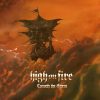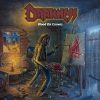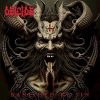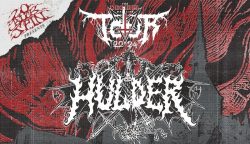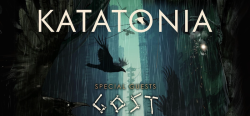Naeramarth – Looking to the Stars
Friday, 10th November 2017
Sometimes you just have to marvel at the melting pot that is today’s metal scene. You can get some of the craziest concoctions of material, blending together genres that you wouldn’t think of putting together, or natural refinements that impress with their fluidity and structure. Naeramarth is a new, one-man act (of Gage Love) that brings together more extreme elements of black and death metal with progressive vibes of bands like Leprous. The result is a unique listen that not only came out of nowhere, but one that is sure to impress.
The Innumerable Stars is the debut at hand, though it feels more like a veteran offering. The wide breadth of genre fusion is handled gracefully and with an emotive core in mind. Progressive leanings as they may, there’s some strong atmosphere that is handled as well, which gives it further strength. As is the case with acts that tend to pop up out of the woodwork, we fired off some questions for Love. The usual topics of the band’s beginnings and plans are covered, as well as Love’s passions outside of music and favorite releases of 2017.
Dead Rhetoric: How did you come up with the name Naeramarth?
Gage Love: Naeramarth (roughly pronounced N-eyeh-ra-marth) is a Sindarin Elvish word from the Children of Húrin saga found in The Silmarillion by J.R.R. Tolkien. My particular usage stems from the tragic death of the character Niënor (or Níniel), who leaps to her death in a river chasm after some startling revelations are made in the final act of the story. This river chasm is called Cabed Naeramarth, which translates to the “Leap of Dreadful Doom”. The film score-inspired “Cabed Naeramarth” interlude on “The Innumerable Stars” serves as a requiem or “death scene” for Niënor. This saga, based on the Finnish epic poem, The Kalevala, has always been one of my favorite pieces of literature and the name references the depth of emotion (and often sorrow) I try to convey with my music.
Dead Rhetoric: Where did the idea for Naeramarth stem from?
Love: Naeramarth was originally going to be a Tolkien-themed progressive black metal project, but as I began writing it quickly moved away from that narrow scope. As one can probably gather from the release, I have a very broad musical taste, which inevitably manifests itself into anything I write. Thus, Naeramarth is a vehicle for me, in an extreme metal context, to explore all the various genres I am passionate about, including 70s prog, black, death, doom, and power metal, as well as electronic/synth, classical, and film score music.
Dead Rhetoric: How would you describe the sound of Naeramarth to someone unfamiliar with the band?
Love: Naeramarth is a progressive extreme metal band which uses the sonic palette of Mellotron-heavy 1970s prog (e.g. King Crimson and RPI bands such as Premiata Forneria Marconi) and synthesizes the progressive and Scandinavian-leaning elements of black, death, and doom metal with the epic, symphonic bombast of film scores and European power metal. With so many influences, Naeramarth can often be hard to categorize. Something that’s been personally fun for me is to see people’s reactions to the album and how they classify its genre. My favorite so far was something to the effect of “atmospheric symphonic progressive doom/death/black one man band”. I think that works pretty well!
Dead Rhetoric: Can you speak to your songwriting process? Did it differ at all for the lengthy “Through the Cosmos II: The Arrival?”
Love: I tend to write in a very linear way compared to some guitarists, who will sit down and write catalogues of riffs and puzzle them into complete songs. I typically write songs from start to finish and generally only even save parts or riffs if I think they’re ultimately worthy of a final album. Thus I don’t have a huge backlog of demos and unused material. I also have a tendency toward writing linear song structures as well, with little repetition. I do still try to incorporate choruses and a lot of melody so that the songs stay memorable and interesting. “Lunar Sea” is the most straight-forward song on the album and was a rare exercise in trying to write a song with a very simple structure and an infectious chorus. While “The Innumerable Stars” is not strictly a concept album, I stuck lyrical and melodic themes or motifs throughout the entirety of the album. That idea comes mostly from film scores, but a lot of the best progressive music shares that same approach. My hope is that those details will translate into a deeper experience for listeners.
“Through the Cosmos II: The Arrival” follows this linear trend and the use of motifs, but differs in that I had a visual and narrative concept in place before I began writing. People won’t know unless they’ve seen the album booklet, but the song is divided into six movements (mostly inspired by my deep love for Italy’s mightiest warriors, Rhapsody and Luca Turilli). The song follows a character who sets out on a cosmic journey through a singularity to find the source of all truth. Upon their arrival, the character finds that there is no inherent meaning to anything, grapples with that realization, and resolves to define, understand, and ultimately treasure their own improbable existence in the universe. The narrative essentially mirrors my own journey out of the Mormon church and religion in general a number of years ago. So, I suppose this song is a bit more of a cosmic, existentialist film score than the others on the record!
Dead Rhetoric: What can you say of the cover art for The Innumerable Stars?
Love: Interestingly enough, the final cover art is actually the second cover for the album. I had announced the original cover art back in January 2017 with a “set it and forget it” mentality. Fast forward to two weeks before the release and I get a message that an Australian Psych Doom band called Adrift for Days (check ‘em out!) had released a new album with an essentially-identical cover in June 2017. Now, luckily I hadn’t printed any physical copies, but this sent me into a mad scramble to get a new cover.
The new cover was crafted by a local Salt Lake City photographer and glitch artist named J.L. Feveryear, who is a good friend of mine that I had always planned on working with at some point in the future. He was kind enough to bail me out and create a stunning cover in a very short amount of time. This whole episode was extremely stressful, but in the end I have what I think is a beautiful cover that perfectly conveys the spirit of the album. Moral of the story for DIY bands? Never use stock photos.
Dead Rhetoric: How did you get Jørgen Munkeby to perform on the song “Luminous Beings?”
Love: I really wish this story were more glamorous! I had been a big fan of Jørgen’s work in Norway’s Shining and as a guest on Ihsahn’s records since I first heard him play on Ihsahn’s After, which was a very pivotal album for me. The initial melody line of “Luminous Beings” was originally a bass solo when I demoed it in 2013, but when I came back to produce the full length last fall/winter, I knew I wanted it to be a sax.
Operating off of a little Stratovarius-style “fantasy can become reality” thinking, I heard that Jørgen did some session work and just said “what the hell” and emailed him with the rough mix tracks and he kindly accepted the gig. I couldn’t be happier with how it turned out. His performance really took that song to the next level. Plus, he’s the nicest guy and a real joy to work with. He has a very exciting body of work and I’m always interested to see what he does next.
Dead Rhetoric: What do you like and dislike about Naeramarth being a one-man act?
Love: As a slightly neurotic perfectionist, it’s comforting to have full creative control over the music, aesthetic, and marketing of the band. I grew up in a very DIY-oriented music scene in the Quad City area of Illinois/Iowa and have always gravitated towards those types of communities. I try to stay true to that DIY mentality with everything I do and always focus on the music and the community. While I strive to make Naeramarth look and sound very professional, I hope the project translates as very authentic, with an “underground DIY” approach rather than a “corporate DIY” approach.
Being a one-man act also has its drawbacks. Naeramarth is entirely my responsibility and it’s a ton of work. I write, record, and mix everything myself. I run the Bandcamp and all of the social media. My wife and I create all the visuals and marketing. When it comes time for release, I’m the one sending out review requests and press kits. Without a label it can be expensive, exhausting, and quite daunting trying to get this record out there. Starting as a one-man band from absolute obscurity can also mean making some sacrifices at the beginning (like a studio drummer or physical copies) until enough people catch on.
That being said, with tools like Bandcamp and the help of the underground community, there’s no better time to be a solo artist. Hails to all who have supported and spread the release so far. It’s been an honor to meet such genuine, kind, and passionate new friends from the metal and prog communities all over the world.
Dead Rhetoric: Are there any plans to play live shows or is this a studio-project only? Would you consider turning Naeramarth into a full-band?
Love: Naeramarth is primarily a studio project, but I do have plans to start developing it in a live setting. Paul Black, who did the harsh vocals on the album, will definitely be joining me as well as another close friend on guitar and back-up vocals. I’ll be on the hunt for a live drummer, bassist, and perhaps a keyboardist. A densely-layered project like Naeramarth will rely heavily on backing tracks for all the orchestration, choirs, and electronics, so it’ll be some work to set that up as well. I’m definitely more focused on studio work at this point, but live shows will definitely be in the works!
Dead Rhetoric: What are some of the goals you have for Naeramarth, either short or long-term?
Love: In terms of short-term goals, I’ll hopefully be quite busy promoting the current release through the end of the year as well as writing the next EP. In terms of general goals, I just want to keep putting out quality music on a consistent basis – hopefully alternating EPs and Full Lengths every year or two. This project also allows me to develop my production and mixing chops, so one of my foremost goals is to continually improve the production quality and to work with some new guest musicians (including a drummer). Another big goal is to spread Naeramarth far enough to where I can legitimately get more merch and physical copies out there. On that front, I’ll likely be looking into some crowd-funding platforms to possibly get a physical run of the debut sometime in 2018 and I currently have a small run of shirts up on Bandcamp. Of course, working with a label would help a lot, but we’ll have to see what the future holds.
Dead Rhetoric: What are some of your passions that you enjoy outside of music?
Love: You’ve probably already gathered I’m very invested in Tolkien’s work. I’m a big fan of science-fiction and fantasy (in both film and writing). I’m mega-stoked on Star Trek. In terms of sci-fi novels, I really enjoy stories of post- and trans-humanism from authors like Vernor Vinge (A Fire Upon the Deep) and Greg Egan (Permutation City) and stories based on understanding and living in harmony with those different from oneself, such as Octavia E. Butler’s Lilith’s Brood/Xenogenesis trilogy and, though I oppose his politics, Orson Scott Card’s Speaker for the Dead (which happens to be completely antithetical to said politics). For fantasy novels, I usually stick with Tolkien, but I really enjoy Patrick Rothfuss’ Kingkiller Chronicle as well as George R.R. Martin’s A Song of Ice and Fire. My wife Ashley is an artist/illustrator who is developing a graphic novel (we’re both really into Image Comics), so I spend a lot of time with her and our three cats Grim, Tompa (named for At the Gates’ Tomas Lindberg), and Isa (named after both Enslaved’s record and the rune).
Dead Rhetoric: As we move towards the end of 2017, what are some of your favorite releases of the year?
Love: 2017 has been a great year with some really solid releases. I’m currently digging into the new Enslaved record as well as two beautiful memorial records from Hallatar and Bell Witch. At the top for me have been Colorado’s Dreadnought, who created an absolutely astounding progressive trip, A Wake in Sacred Waves. Norwegian progressive rock group Wobbler just released a stunning prog masterclass, From Silence to Somewhere. Dutch avant-garde black/death outfit Dodecahedron put out a stellar record called Kwintessens. Pillorian’s Obsidian Arc (ex-Agalloch, Uada) has been getting continual plays since it came out. Earth Electric’s Vol. 1: Solar is a great piece of female-fronted psychedelic/progressive hard rock with Rune Eriksen (ex-Mayhem, Aura Noir). Germany’s Der Weg einer Freiheit put out another solid atmospheric BM record, Finisterre. My buds in Wisconsin Doom/Black outfit Bereft had a very solid release called Lands.
Colorado’s Dark Descent label has had a hell of a year with great black and death metal releases from Bestia Arcana, Nightbringer, Phrenelith, Undergang, and Spectral Voice. Germany’s WTC Productions had great releases this year, my favorite being Gnosis Kardias from Czech Psychedelic BM group Inferno. I was very impressed with the new Septicflesh record (Greek symphonic death metal). I quite enjoyed the new Leprous and Steven Wilson releases. And finally, in the electronic sphere, Venezuelan producer Arca (who collaborates with Björk) put out an incredible self-titled record and I still can’t stop listening to Ulver’s The Assassination of Julius Caesar; it may be my highest-played album of the year. There are definitely some other great ones and I’m sure as we approach end-of-year list season we’ll all find some gems we overlooked. I’m still looking forward to new records from Aosoth and Blut Aus Nord.
Dead Rhetoric: With The Innumerable Stars now released, what lies ahead for Naeramarth?
Love: In keeping with the original intent of the project, all the releases from now on will be Tolkien-themed. With Naeramarth, I’d like to contribute something different than Summoning or Blind Guardian; perhaps less literal and more focused on the emotion of the characters and story. I’m currently writing what is planned to be a five song concept EP based on the story of Aredhel in the Silmarillion. Tolkien has a handful of strong, interesting, and lesser known female characters in the Silmarillion, whose stories I’d love to delve into in the future. Expect a darker, heavier, but still progressive iteration of Naeramarth next time around, with more death/doom influence. I’d like to have it out near the end of 2018, but we’ll see how it goes. I have the song titles and EP title ready, but stay tuned for those as we get closer to release sometime next year. Also, Paul Black and I recently helped our valiant brothers in SLC epic heavy metal band Visigoth with some choirs/backing vocals on a handful of songs for their upcoming record, so that’s probably where you’ll hear my voice next. Hails!
Photo Credit: Black Marble Photography
















